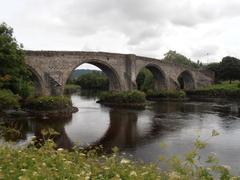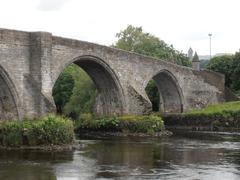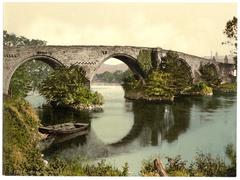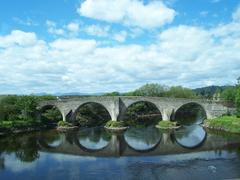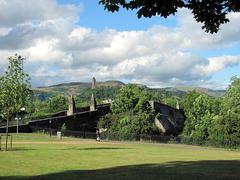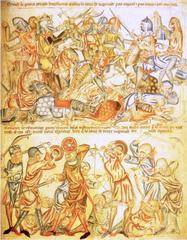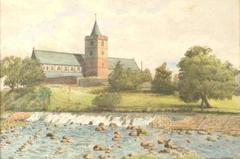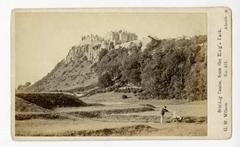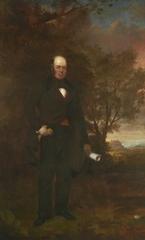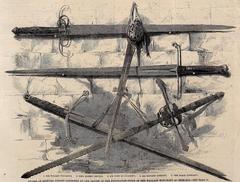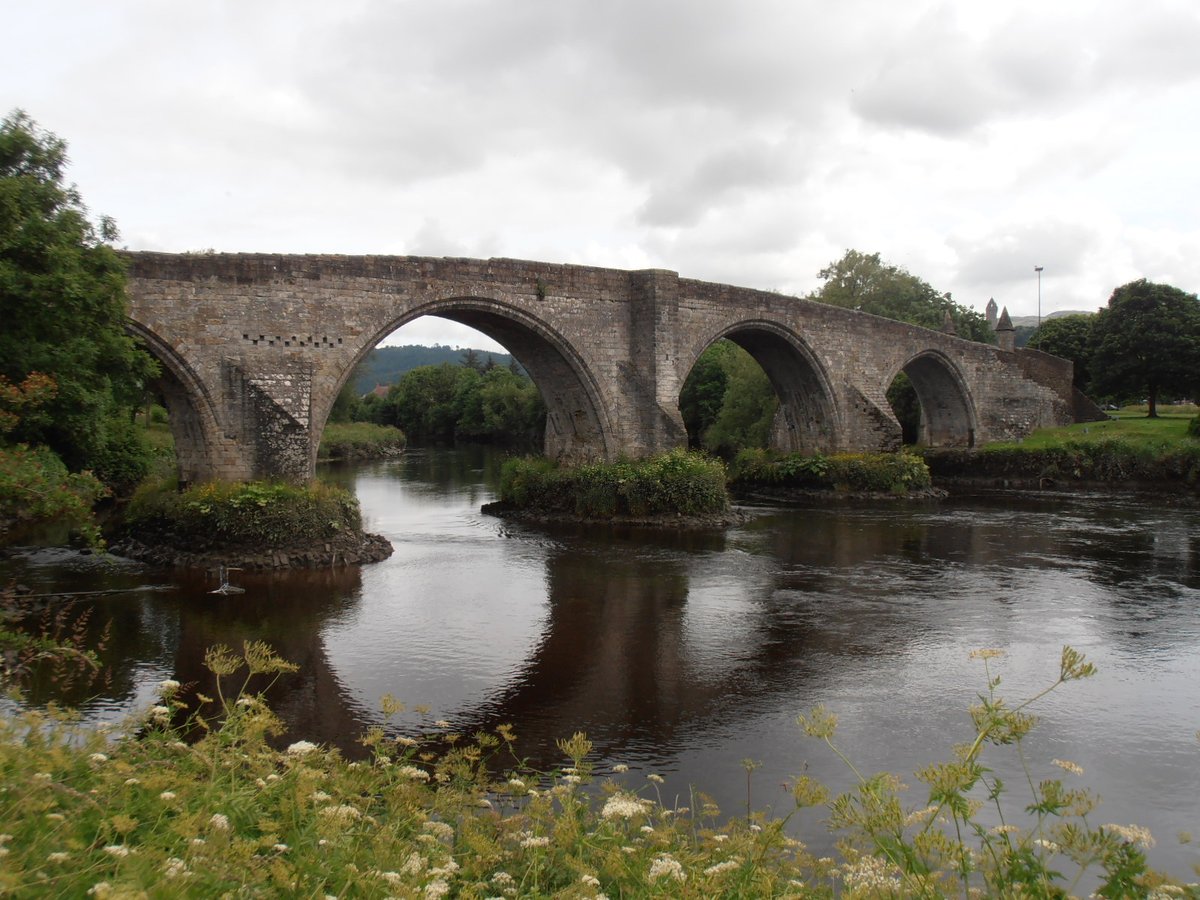
Visiting Stirling Bridge: History, Tickets, and Tips
Publication Date: 23/07/2024
Introduction
Stirling Bridge, located in Stirling, Scotland, is much more than just a crossing over the River Forth; it is a symbol of Scottish resilience and historical significance. The bridge’s strategic location made it a focal point for both military and trade activities, serving as a critical crossing between the Scottish Highlands and Lowlands. The most notable event associated with Stirling Bridge is the Battle of Stirling Bridge, which took place on September 11, 1297. Scottish forces, led by William Wallace and Andrew Moray, achieved a decisive victory against the English army, marking a pivotal moment in the First War of Scottish Independence (Historic Environment Scotland).
The original wooden bridge that stood during the battle was replaced by a more durable stone structure in the early 15th century. This medieval stone bridge, which dates back to around 1410, has undergone several restorations to preserve its structural integrity and historical value (Undiscovered Scotland). Today, Stirling Bridge is a pedestrian-only crossing, attracting numerous visitors who come to appreciate its historical significance and scenic views of the River Forth.
In addition to its historical and architectural significance, Stirling Bridge has left a lasting impact on Scottish culture and identity. The Battle of Stirling Bridge is celebrated in Scottish folklore and literature as a symbol of resistance and national pride. The nearby Wallace Monument, completed in 1869, celebrates the life and legacy of William Wallace and offers panoramic views of the surrounding area (Wallace Monument).
This comprehensive guide aims to provide you with all the essential information you need for a memorable visit to Stirling Bridge, including its historical background, visitor tips, and nearby attractions. Whether you’re a history enthusiast or a casual traveler, this guide will help you make the most of your trip to this iconic landmark.
Table of Contents
- Introduction
- Historical Background
- Visitor Information
- Nearby Attractions
- Accessibility
- FAQ
- Conclusion
Historical Background
Early History and Strategic Importance
Stirling Bridge, located in Stirling, Scotland, has been a site of immense historical significance due to its strategic location. The bridge spans the River Forth, which has historically served as a critical crossing point between the Scottish Highlands and Lowlands. This geographical positioning made Stirling Bridge a focal point for military and trade activities. The earliest records of a bridge at this location date back to the 13th century, although it is believed that a wooden structure existed even earlier.
The Battle of Stirling Bridge (1297)
One of the most pivotal events in the history of Stirling Bridge is the Battle of Stirling Bridge, which took place on September 11, 1297. This battle was a significant conflict during the First War of Scottish Independence. Scottish forces, led by William Wallace and Andrew Moray, achieved a decisive victory against the English army commanded by John de Warenne, the Earl of Surrey, and Hugh de Cressingham. The battle’s success was largely due to the strategic use of the narrow bridge by the Scottish forces. As the English troops attempted to cross the bridge, they were bottlenecked and became easy targets for the Scots. This victory not only boosted Scottish morale but also established William Wallace as a prominent leader in the fight for Scottish independence (Historic Environment Scotland).
Architectural Evolution
The original wooden bridge that stood during the Battle of Stirling Bridge was eventually replaced by a stone structure in the early 15th century. The current stone bridge, which dates back to around 1410, was constructed to provide a more durable and reliable crossing. This medieval stone bridge features four arches and is approximately 90 meters long. It has undergone several restorations over the centuries to preserve its structural integrity and historical value (Undiscovered Scotland).
Role in Subsequent Conflicts
Stirling Bridge continued to play a crucial role in subsequent historical events. During the Wars of the Three Kingdoms in the mid-17th century, the bridge was a strategic point for both Royalist and Covenanter forces. Its control was essential for the movement of troops and supplies. The bridge’s significance persisted into the Jacobite uprisings of the 18th century, where it again served as a vital crossing point for armies.
Preservation and Modern Significance
In the 19th and 20th centuries, efforts were made to preserve Stirling Bridge as a historical monument. The bridge was closed to vehicular traffic in the 1930s to protect its structure, and it is now a pedestrian-only crossing. Today, Stirling Bridge is a Category A listed structure, recognized for its historical and architectural importance. It attracts numerous visitors who come to appreciate its historical significance and scenic views of the River Forth (Historic Environment Scotland).
Commemorations and Memorials
Several commemorations and memorials have been established near Stirling Bridge to honor its historical significance. A notable example is the Wallace Monument, located on Abbey Craig, overlooking the site of the Battle of Stirling Bridge. This monument, completed in 1869, celebrates the life and legacy of William Wallace. Additionally, plaques and information boards near the bridge provide visitors with insights into its historical context and the events that unfolded there (Wallace Monument).
Cultural Impact
Stirling Bridge has also left a lasting impact on Scottish culture and identity. The Battle of Stirling Bridge is often celebrated in Scottish folklore and literature as a symbol of resistance and national pride. The bridge and its associated history have been depicted in various artistic works, including paintings, poems, and films. The story of William Wallace and the Battle of Stirling Bridge was famously dramatized in the 1995 film ‘Braveheart,’ although the film took significant creative liberties with historical accuracy (IMDb).
Archaeological Discoveries
Archaeological investigations around Stirling Bridge have uncovered artifacts and remnants that provide further insights into its historical significance. Excavations have revealed medieval pottery, weaponry, and other items that shed light on the daily life and military activities in the area. These discoveries contribute to a deeper understanding of the bridge’s role in Scottish history and its impact on the surrounding region (Archaeology Scotland).
Educational and Interpretive Programs
To enhance public understanding of Stirling Bridge’s historical importance, various educational and interpretive programs are offered. Guided tours, interactive exhibits, and reenactments of the Battle of Stirling Bridge are available to visitors. These programs aim to provide an immersive experience, allowing visitors to connect with the past and appreciate the bridge’s role in shaping Scottish history (Visit Scotland).
Visitor Information
Ticket Prices
Currently, there is no charge to visit Stirling Bridge. However, nearby attractions like the Wallace Monument may have entry fees.
Opening Hours
Stirling Bridge is accessible to visitors year-round. However, it is advisable to check the specific opening hours for nearby attractions and visitor centers.
Travel Tips
- Getting There - Stirling Bridge is easily accessible by car, bus, and train. The nearest train station is Stirling Station, which is a short walk from the bridge.
- Best Time to Visit - For the best experience, consider visiting during the spring or summer months when the weather is pleasant and the surrounding area is in full bloom.
- Guided Tours - Consider booking a guided tour to gain deeper insights into the historical significance of the bridge and surrounding landmarks.
Nearby Attractions
- Wallace Monument - A towering structure dedicated to William Wallace, offering panoramic views of the surrounding area.
- Stirling Castle - One of Scotland’s grandest castles, rich in history and offering various exhibits and tours.
- The Battle of Bannockburn Visitor Centre - An interactive experience that brings the Battle of Bannockburn to life.
Accessibility
Stirling Bridge is accessible to pedestrians, including those with mobility impairments. However, some areas may have uneven surfaces, so caution is advised. Nearby attractions generally offer good accessibility features, including ramps and accessible restrooms.
FAQ
-
What are the visiting hours for Stirling Bridge? Stirling Bridge is open to visitors year-round. Specific hours for nearby attractions may vary.
-
How much are tickets for Stirling Bridge? There is no charge to visit Stirling Bridge itself. Nearby attractions may have entry fees.
Conclusion
Stirling Bridge stands as a testament to Scotland’s rich and tumultuous history. Its strategic importance, architectural evolution, and role in significant historical events make it a site of enduring interest. Through preservation efforts, commemorations, and educational programs, Stirling Bridge continues to be a place where history comes alive for visitors from around the world (Historic Environment Scotland).
The bridge’s impact extends beyond its historical and architectural significance to its role in shaping Scottish culture and identity. Commemorations like the Wallace Monument and various educational programs help keep the legacy of Stirling Bridge alive, allowing visitors to connect with the past in meaningful ways (Wallace Monument).
Whether you’re visiting for its historical significance, its picturesque views, or its cultural impact, Stirling Bridge offers a multifaceted experience that is both educational and enriching. With this comprehensive guide, you are well-equipped to make the most of your visit, from understanding its historical context to exploring nearby attractions. Don’t forget to download our mobile app Audiala for more travel tips and updates, and follow us on social media to stay informed about other historical sites and travel guides.
References
- Historic Environment Scotland. (n.d.). https://www.historicenvironment.scot/
- Undiscovered Scotland. (n.d.). https://www.undiscoveredscotland.co.uk/
- Wallace Monument. (n.d.). https://www.nationalwallacemonument.com/
- Visit Scotland. (n.d.). https://www.visitscotland.com/
- Stirling Walking Tours. (n.d.). https://www.stirlingwalkingtours.com/
- Scotrail. (n.d.). https://www.scotrail.co.uk/
- BBC History. (n.d.). https://www.bbc.co.uk/history
- Archaeology Scotland. (n.d.). https://www.archaeologyscotland.org.uk/
- IMDb. (n.d.). https://www.imdb.com/
